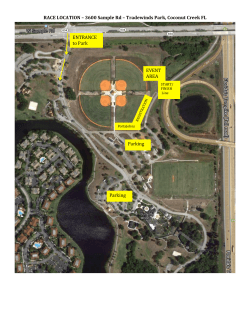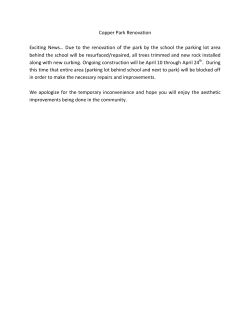
SF Park: Lessons Learned from a Market
SF Park: Lessons Learned from a Market-Priced Parking Experiment Presented by Michael Manville, Department of City and Regional Planning, Cornell University SFpark: Preliminary Lessons Learned Michael Manville Cornell University Lessons Learned • 1. The Status Quo is unsustainable • 2. Street parking is miss-‐priced – Slightly more overpriced than underpriced – But biggest costs come from underpricing • 3. Market pricing is easier said than done – Price controls – Tradeoff between accuracy and stability Lessons Learned • 4. Lots of people don’t pay – Double-‐parking, evasion, placards • 5. (Time PermiOng) PoliQcal controversy & next steps The Street Parking Status Quo • CiQes want parking to be three things: – Easy to find – Cheap – A reliable source of revenue – You can’t have all three Most Spaces Aren’t Metered, Most Prices Don’t Change • San Francisco: over 90 percent of street spaces free • Prices don’t rise even as value of land does 1.Taxes on commercial parking 2.Fines and fees Punishment Rather than Performance • • • • • SF: Most street spaces – free Most metered spaces: < $3.00 Parking violaQon: $73 2006-‐2007: $97 million from parking user charges $90 million from fines – many street cleaning violaQons • Not a good way to raise parking revenue • “Punishment is a cost, not a benefit” In Sum • CiQes overcharge violators to undercharge drivers • Undercharging drivers -‐> shortages • Most violators (over 90 percent) aren’t caught – Enforcement is expensive, placard fraud rampant • So the typical motorist – Can’t find a space – Gets an occasional disproporQonate fine – Knows many people get away with what he got punished for – Resents the en7re priced-‐parking system and thinks it’s incoherent and illegi7mate The Experiment • Approximately 7,000 spaces • “Treatment” and “control” streets • Digital meters, sensors under spaces, relaxed Qme limits • Prices adjusted based on occupancy The TransiQon to Performance Pricing: How Do You Do It? Block-‐Timeband Pricing • Each block gets three unique prices – – – – – 9 am to noon Noon to 3 pm 3 pm to close Weekday vs weekend All prices adjusted based on occupancy Price Adjustments: Dynamic but Controlled • • • • • • • Average occupancy 60-‐80%: no price change 30-‐60%: price falls 25 cents <50%: price falls 50 cents >80%: price rises 25 cents Price adjustments made every 8 weeks Prices can’t >$6/hr or <$0.25/hr Infrequent, incremental, floors and ceilings, easier to fall than rise What We Learn: Parking Markets are Very Local Did SFpark Work? Yes -‐ SFpark blocks hit target occupancy more open Maybe -‐ Minimum vacancy improved, but not by as much; partly a result of price controls Average Occupancy is Not Minimum Vacancy • Ten meters, three hours = 1,800 minutes • Cars park for 1,200 minutes = 67 percent occupancy • No price change • But this says nothing about distribu7on of those 1,200 minutes • Could be spread evenly across three hours • Or could be two straight hours of zero vacancy Occupancy is important, and easy to measure, but vacancy is what drivers want Minimum Vacancy Might Deliver More Benefits • Going from 100% to 90% occupancy probably bever than going from 55% to 65% • Reduces cruising • But this could require very high prices, very frequent changes, or both • SFpark allowed neither The “Menu Pricing” Dilemma • Money cost vs transacQon costs • SoluQon -‐ an app: use real-‐Qme informaQon instead of real-‐Qme price changes • But … do we want drivers looking at phones? Compliance – The Good News CitaQons declined in priced-‐parking areas (credit cards) Compliance – The Bad News • SFpark had 223 blocks • 14 (6 percent) averaged over 85 percent compliance • 12 percent of blocks – fewer than 40 percent of vehicles paid • 40 percent of blocks: 60 percent or less About 40 percent of minutes unpaid, placards are 30 percent of unpaid minutes The Trouble with Placards • • • • • Easy to obtain IncenQve to use rises with price Increased enforcement doesn’t help Distorts the price signal Cynicism about people with legiQmate disabiliQes Conclusions • Very promising evidence that performance prices can help manage occupancy • More work to be done about maintaining vacancy • Parking reform depends crucially on enforcement Expansion • Which is more important? – Change the pricing of exisQng meters? – Get meters into unpriced areas with high demand? • Addressing high demand probably has more benefits, but also more poliQcal risks • SFpark’s avempted expansion into unmetered Eastern Neighborhoods triggered a backlash • 13,400 vehicles observed through repeated surveys of 50 SF blocks • Price increases did improve occupancy levels (rates rose $1, occupancy fell 10 percent) • But increases had no discernible impact on minimum vacancy • Partly a result of price controls – prices never got high enough
© Copyright 2025









